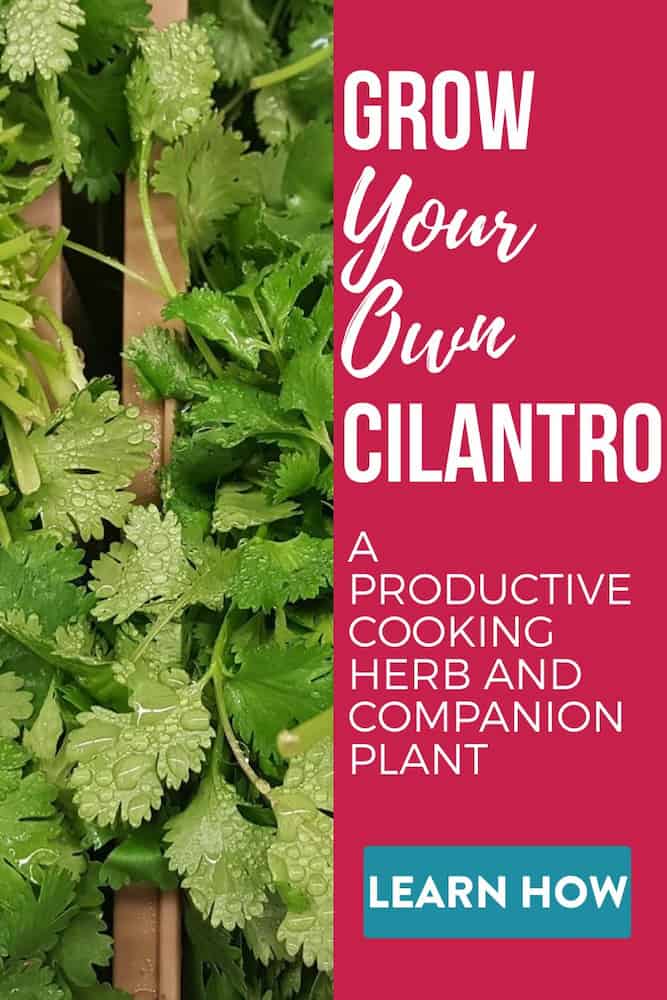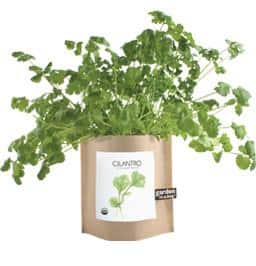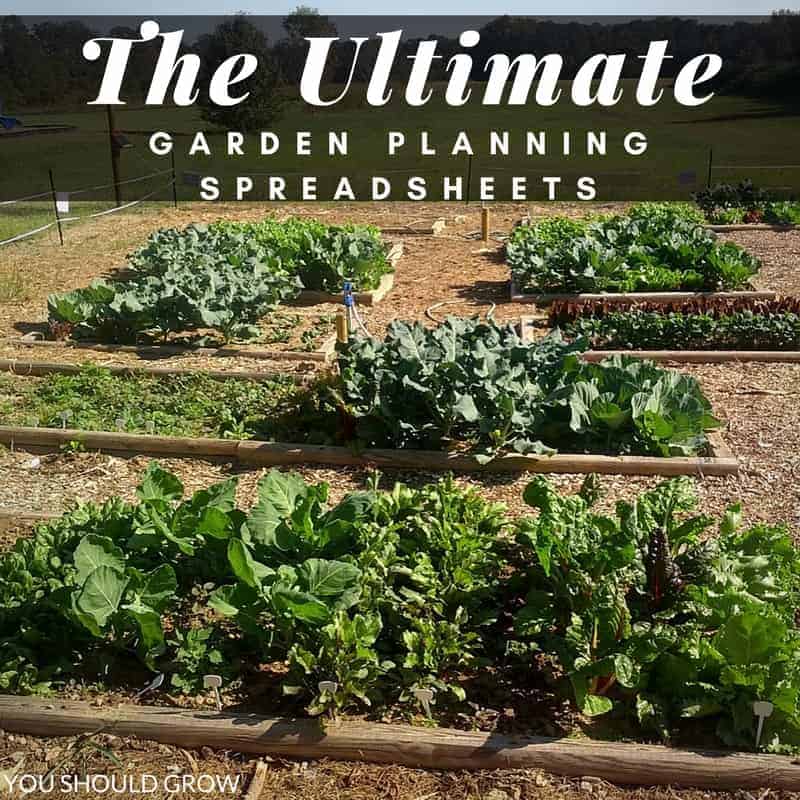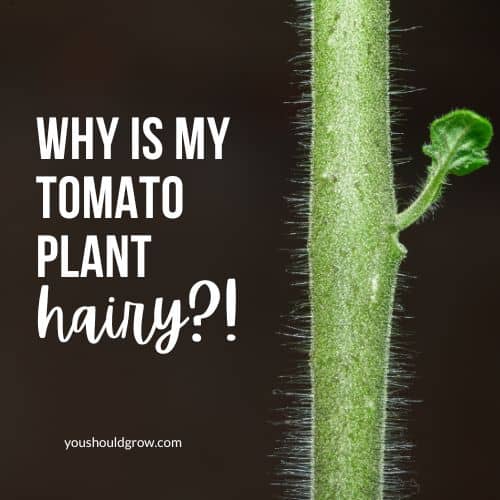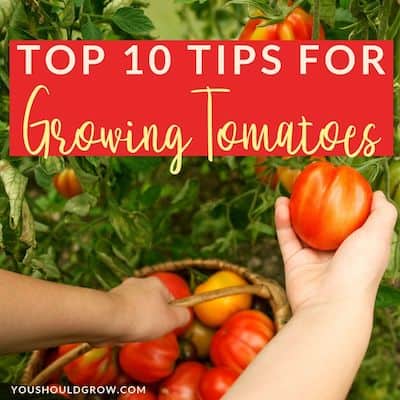Love It Or Hate It, You Should Grow Cilantro
As an Amazon Associate and member of other affiliate programs, I earn from qualifying purchases.
Cilantro is easy to grow if you know what you’re doing, and growing cilantro can benefit your garden even if you’re not a fan of the flavor. As with other crops, the flavor of fresh cilantro has a lot to do with how it’s grown and harvested, so we’ll talk about what you can do to get the best tasting cilantro from your garden.
Cilantro may be one of the most polarizing cooking herbs. Some people love it, and to others, its flavor has no place in the kitchen. But even if you’re anti-cilantro in your food, we say this plant still deserves a spot in your kitchen garden.
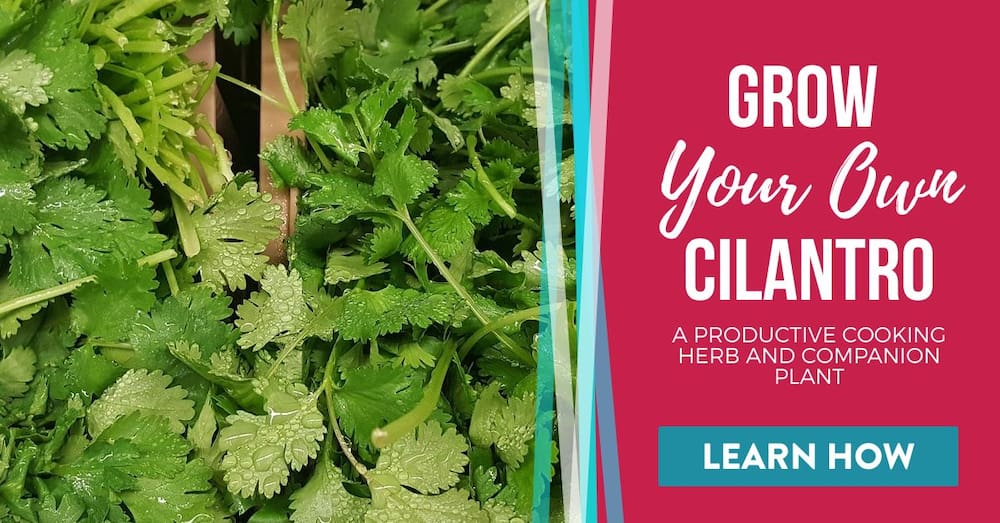
How To Grow Cilantro
The most important factors for growing cilantro are soil, sunlight, and temperature.
● Always use the highest quality garden or potting soil you can find. Better soil always grows healthier plants, and even though cilantro isn’t necessarily a heavy feeder cruddy soil will yield cruddy results.
● Cilantro needs full sun – that’s at least 6 hours of sunlight per day. But it will benefit from afternoon shade where summers are hot.
● Cilantro prefers mild weather, so plant your seeds in the garden after all chance of frost has passed and your soil temperature is at least 55F.
● Most areas get too cold in the winter for cilantro to survive, however, cilantro can be grown as a perennial in some locations.
● Problems with cilantro bolting are variety dependent and more of an issue in hot summers. Get slow bolting heirloom cilantro seeds here.
Starting Cilantro From Seed
When you’re looking for cilantro seed, try to get a slow bolt variety. Bolting, or going to flower, is one of the biggest problems with cilantro plants. Slow bolt varieties have been bred to take long to go to flower which means you’ll get more harvest.
Here is our recommended source for slow bolting cilantro seeds.
Fun fact:
Cilantro seeds are called coriander. Coriander is the spice of the seed and cilantro is the leaves and stem of the herb grown from coriander seeds.
When it comes to planting coriander, I prefer to start seeds directly in the garden. We have a nice long growing season, and I can usually get 2 or 3 crops of cilantro before our first frost.
You can also start cilantro seed indoors a couple of weeks before your last frost and plant young seedlings in the garden after all chance of frost has passed.
Germination time can take up to 2 weeks both indoors and out. Soil temperature and moisture are the most important factors for germination. If it’s too cold, wet, or dry, the seeds will be slower to sprout or not sprout at all. Warmer soil and even moisture can speed up germination.
Growing cilantro indoors
I like to grow cilantro indoors using the Aerogarden. But you can also grow it in a small container on your windowsill.
When growing cilantro indoors, remember the most important things: soil, sunlight, and temperature. Cilantro needs to be in a sunny south-facing window or, even better, under a small tabletop grow light.
If you’re focusing on indoor gardening, think about growing cilantro microgreens for a fun and spicy addition to your salads and salsa.
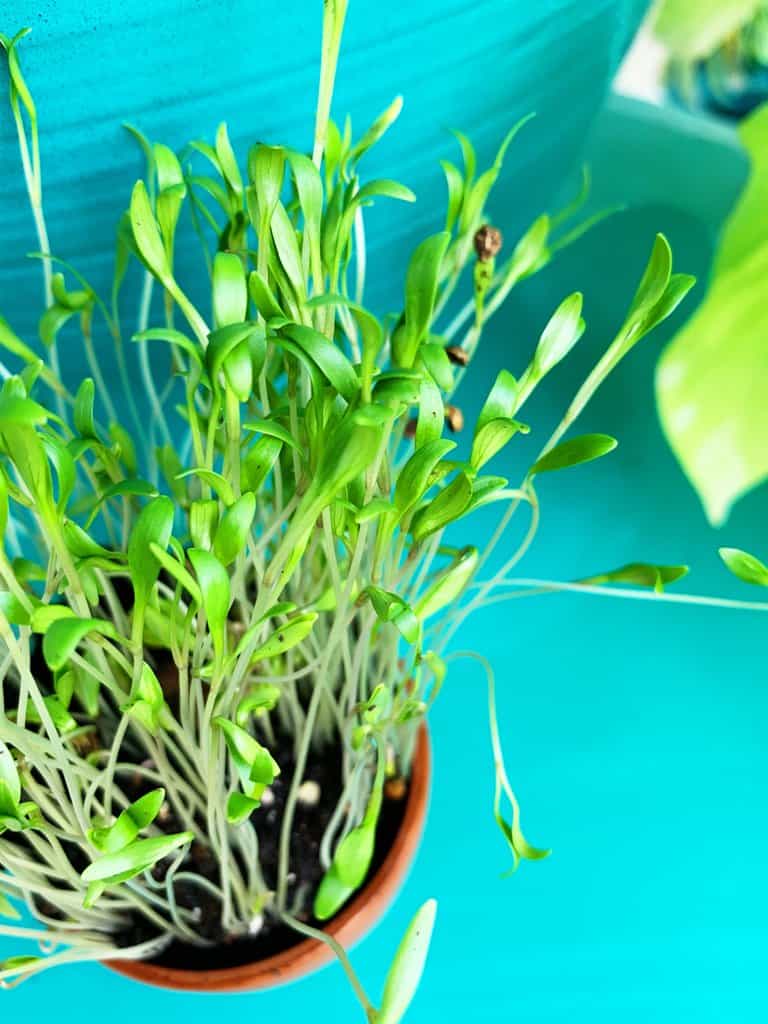
Growing cilantro in the garden
Once coriander seeds have sprouted, they will grow pretty quickly. To encourage lots of leaf growth, start supplementing with a high nitrogen fertilizer at about 4 weeks old.
Later in the season, cut back on nitrogen fertilizer if you are growing cilantro with any fruit bearing plants like tomatoes. Too much nitrogen can decrease your tomato crop and lead to blossom end rot.
Harvesting cilantro is as simple as cutting the leaves off plants as you need them. Wait until your plant is about 6 inches tall before pruning, and do not take more than 50% of the plant per harvest.
Unless you’re growing a slow bolt variety, expect your cilantro to start to flower as soon as the weather gets warm. Often, I’ll only get a couple of harvests off the plant before it goes to flower.
Cilantro makes a great companion plant for most vegetables and herbs. The strong odor can repel pests from tomatoes and peppers, and the flowers will attract beneficial insects to your garden.
Many gardeners plant cilantro simply for its companion planting benefits.
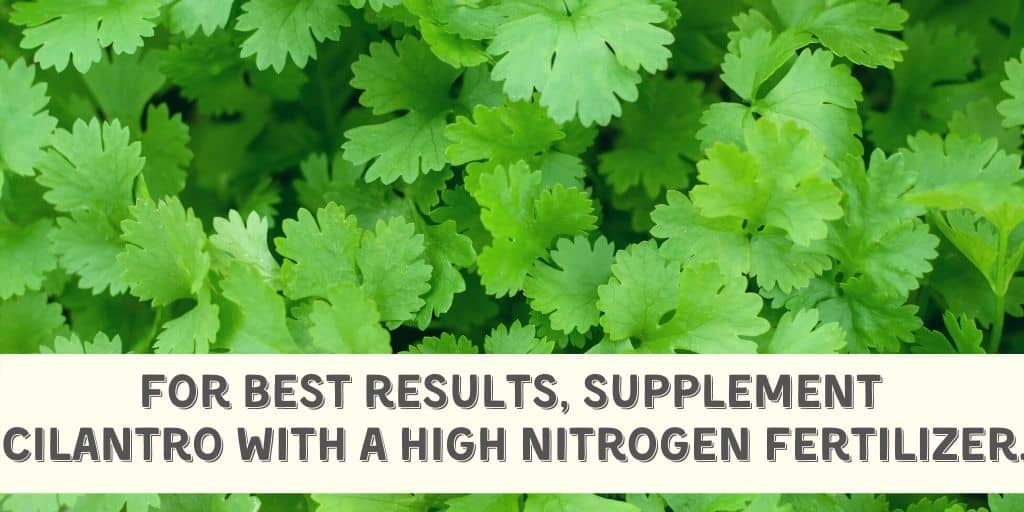
How to harvest cilantro for the best flavor
● Cilantro is a cool season herb that can be grown in the spring and the fall. The flavor is best when the plant is young and the weather is cool.
● Get more harvest by planting a new crop of cilantro every 2-3 weeks (this is called succession planting). Leave the older plants to bolt and attract beneficial insects with their flowers.
● Cilantro can be grown indoors on your windowsill, in an Aerogarden, or as microgreens. Learn about growing microgreens here.
● Pruning cilantro to half its size can encourage new growth and slow bolting, but usually not for very long.
● Larger older leaves will taste bitter – especially if harvested after the flowering.
If you suffer from cilantro taste aversion, you may be genetically sensitive to its strong odors. In that case, Italian parsley makes a great substitute, but feel free to try any green leafy herb that you like including basil, oregano, or mint.
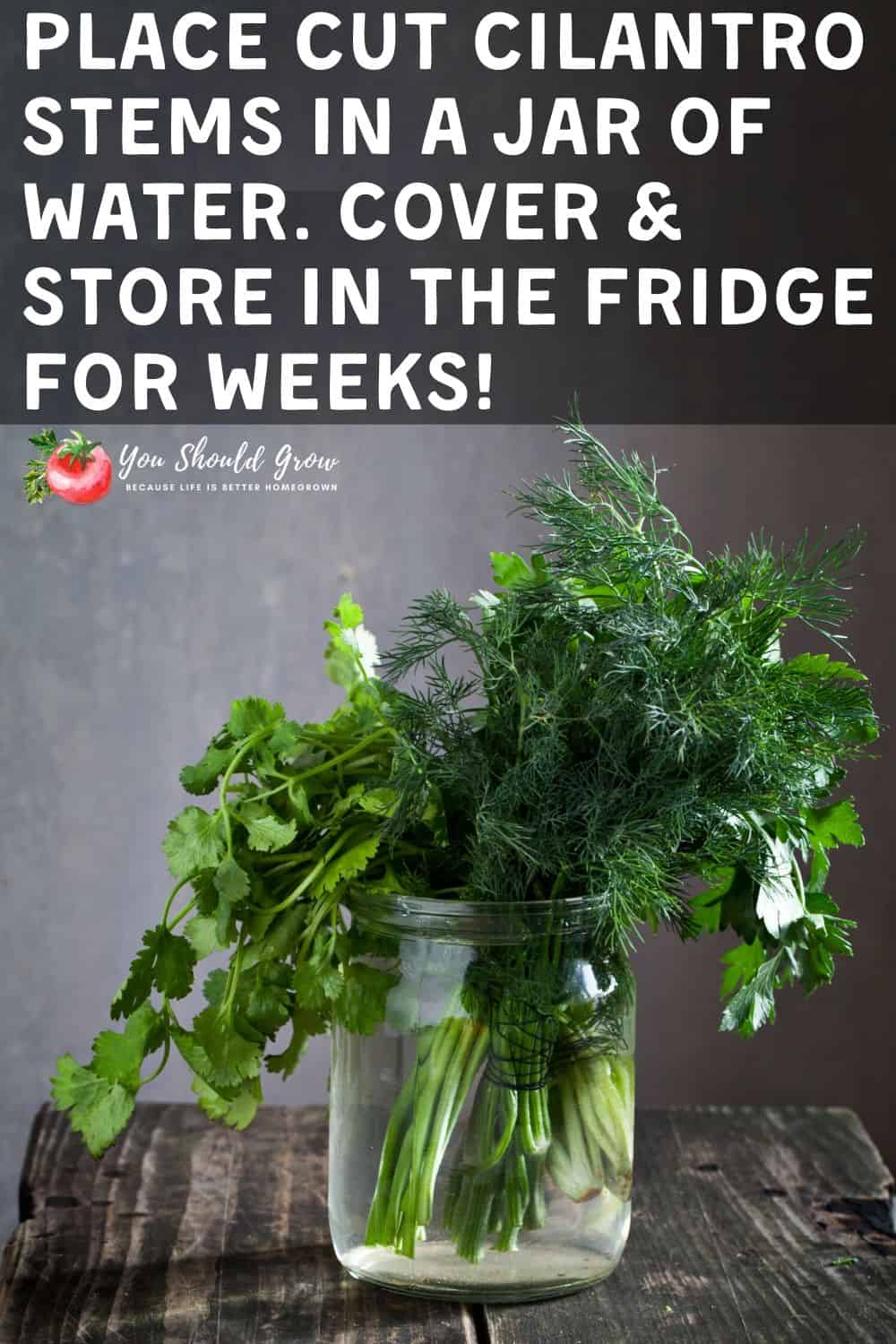
Storing Fresh Cilantro
Because cilantro is a cool season herb, the best place to store your fresh cilantro is in your refrigerator. Keep the cut endo of cilantro stems in a little bit of water and seal the container or cover the leaves loosely with a bag.
When stored this way, you can keep cilantro fresh for a couple of weeks. This method works best because it limits the freshly cut cilantro’s exposure to light and oxygen which keeps it from turning yellow or brown.
Keeping the stems upright in water allows them to have just the right amount of moisture in just the right spaces. Water on cilantro leaves will cause them to turn mushy.
Preserving cilantro
It’s not easy to preserve tender leaves of fresh cilantro. There’s really no way to get preserved cilantro to have as strong a flavor and color as fresh, but if you use cilantro a lot in cooking, here are the best ways to preserve it.
● Dehydrating: Although cilantro can be dehydrated for later use, dried cilantro doesn’t have nearly the same flavor as the fresh leaves.
● Freezing: Place chopped fresh cilantro into an ice-cube tray and cover with some light olive oil to the top of the cube tray. Place in the freezer and store in plastic bags once frozen. Use within 6 months.
● Pesto cubes: another option is to blend cilantro with just enough olive oil to make a paste. Place the paste into an ice-cube tray and freeze. Store frozen cubes in a plastic bag. Use within 6 months.
Love it or hate it, you should grow cilantro
The bright, fresh flavor of homegrown cilantro is a welcome addition to meals in our home, but even if you’re not a fan, growing cilantro has many benefits for your garden.
Established plants require little maintenance, and they can attract beneficial pollinators and predatory insects to your garden to improve the harvest of other veggies you do love.
So we encourage you to give cilantro a chance in your garden, and let us know how it goes in the comments below!


